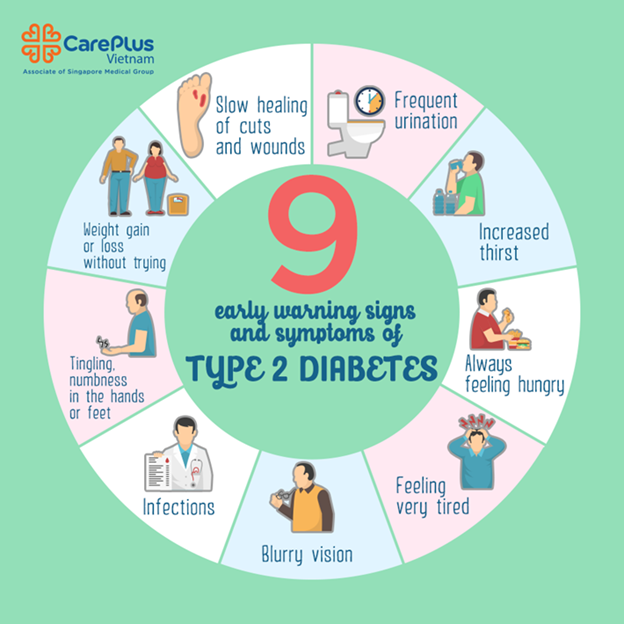Welcome to our blog focused on understanding Type 2 Diabetes symptoms. This health condition affects many people worldwide. Our goal is to shed light on its symptoms, providing crucial insights everyone should know. Recognizing these type 2 diabetes symptoms is important, whether you’re at risk or simply seeking prevention knowledge. Awareness is the first step in addressing symptoms of a Type 2 diabetes. By learning about these signs, you can take proactive steps toward managing your health effectively. Let’s explore this vital topic together, ensuring everyone is equipped with the knowledge they need for better health.

What Is Type 2 Diabetes?
Type 2 Diabetes is a condition where the body doesn’t use insulin properly. Insulin is a hormone that helps glucose (sugar) enter your cells to give you energy. In Type 2 Diabetes, your body resists insulin, often leading to elevated blood sugar levels. It’s different from Type 1 Diabetes, where the body stops producing insulin altogether. The reason for Type 2 Diabetes can include lifestyle factors and genetics. It’s becoming more common, affecting people across all ages, though it used to be seen mostly in adults. Notably, it is prevalent among the Indian population, making awareness even more critical.
Why Are Type 2 Diabetes Symptoms Often Overlooked?
The symptoms of Type 2 diabetes often develop slowly. Most people may not notice them, leading to delayed diagnosis. This gradual onset can make it tricky to spot. Many individuals continue their daily lives without realizing something might be wrong. Common misconceptions further contribute to this delay. People often think if they aren’t overweight or old, they’re not at risk. These type 2 diabetes and symptoms can be mild at first, making it easy to overlook them. It’s essential to demystify this condition so those affected can seek help earlier.
Common Symptoms of Type 2 Diabetes
Understanding the common symptoms of Type 2 Diabetes is essential for early detection:
- Increased Thirst: Feeling thirsty more often is a telltale sign.
- Frequent Urination: Needing to urinate not just a few, but many times throughout the day and night can signal issues.
- Increased Hunger: Feeling unusually hungry even after eating is a common symptom.
- Unexplained Weight Loss: Dropping weight without trying can be a symptom.
- Fatigue: Feeling tired or exhausted most of the time, even with enough rest.
- Visual Disturbances: Experiencing blurred vision or trouble seeing clearly.
- Neuropathy: Experiencing tingling or numbness in the hands or feet.
- Skin Changes: Changes in skin texture or color, sometimes developing patches.
Type 2 diabetes symptoms like leg pain and tingling are usually due to nerve damage. These signs need attention. Spotting these early can make a big difference in managing Type 2 Diabetes mellitus symptoms better.
The Science Behind Diabetes Symptoms
So why do these type 2 diabetes symptoms occur? It all ties back to blood sugar. When your body can’t use insulin properly, sugar builds up in the blood instead of giving energy to cells. High blood sugar can lead to dehydration, causing increased thirst and urination. Fatigue and hunger occur because your body isn’t getting energy properly. Basically, the body struggles to use the glucose, so symptoms arise from lack of energy and sugar build-up elsewhere.
When to Consult a Healthcare Professional
It’s crucial to seek medical advice early, especially if you notice symptoms of Type 2 diabetes in women, as they can be subtler. Key checkpoints include:
- Experiencing any of the main symptoms persistently.
- Having a family history of diabetes.
- Being part of a high-risk group based on ethnicity or lifestyle.
Early detection can prevent complications. Regular check-ups and open conversations with healthcare providers will help.
Steps to Take if Symptoms Are Detected
If you notice Type 2 Diabetes and symptoms, don’t panic. Follow these steps:
- Track Your Symptoms: Write down what you experience and how often.
- Schedule a Medical Visit: Make an appointment with your doctor.
- Prepare for Your Visit: Note any family history and lifestyle habits.
- Engage with Healthcare Providers: Be honest and ask questions about your concerns.
Expect tests to confirm diagnosis, and follow recommendations carefully. Early intervention is key in managing type 2 diabetes mellitus symptoms effectively.
Culturally Relevant Diabetes Management Tips for India
Managing diabetes requires adjustments, especially with diet. Here are some tips suitable for Indian cuisine:
- Incorporate Whole Grains: Opt for brown rice or whole wheat instead of refined grains.
- Choose Healthy Oils: Use oils like olive oil or mustard oil.
- Increase Fiber Intake: Include more leafy greens and legumes.
- Monitor Portion Sizes: Be mindful of portion sizes to avoid overeating.
- Stay Active: Regular physical activity, like walking or yoga, helps.
Embracing these lifestyle changes can prevent symptoms of Type 2 diabetes in women from becoming severe.
Debunking Myths about Type 2 Diabetes Symptoms
There are many myths surrounding type 2 diabetes symptoms. One common misconception is that symptoms occur only in older, overweight adults. In reality, anyone can develop symptoms of a Type 2 diabetes. Recognize that children and fit adults can be affected. Empower yourself by understanding the facts.
Encouragement and Empowerment
Understanding these symptoms is vital for making informed health choices. By recognizing and addressing type 2 diabetes symptoms, you can lead a healthier life. Share this information with others, ensuring everyone is informed and able to take proactive steps for better health. Raising awareness helps contribute to a proactive community.

